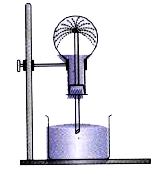What are the sources of error in searlis experiment? How are the errors eliminated searlis experiment?
Step-by-Step Solution
1. Identify the Sources of Error in Searle's Experiment:
- Yielding of the Wire: When a load is applied to the lower end of the experimental wire, the wire may yield. This means that it can permanently deform under the stress, leading to inaccuracies in measurements.
- Improper Adjustment of the Spirit Level: If the air bubble in the spirit level is not properly adjusted, it can lead to incorrect readings of the angle or position of the wire, affecting the accuracy of the experiment.
2. Methods to Eliminate or Minimize Errors:
- Use of Reference Wire: To minimize the effect of yielding, a reference wire can be used alongside the experimental wire. This allows for a comparison between the two wires, ensuring that any yielding affects both wires equally, thus canceling out the error in measurements.
- Thermal Expansion Consideration: Since thermal expansion can affect both wires, using a reference wire helps to measure only the relative increase in length with respect to the reference wire. This minimizes errors due to temperature changes.
3. Conclusion:
- By identifying the sources of error and implementing the use of a reference wire, the accuracy of Searle's experiment can be significantly improved.
- Yielding of the Wire: When a load is applied to the lower end of the experimental wire, the wire may yield. This means that it can permanently deform under the stress, leading to inaccuracies in measurements.
- Improper Adjustment of the Spirit Level: If the air bubble in the spirit level is not properly adjusted, it can lead to incorrect readings of the angle or position of the wire, affecting the accuracy of the experiment.
- Use of Reference Wire: To minimize the effect of yielding, a reference wire can be used alongside the experimental wire. This allows for a comparison between the two wires, ensuring that any yielding affects both wires equally, thus canceling out the error in measurements.
- Thermal Expansion Consideration: Since thermal expansion can affect both wires, using a reference wire helps to measure only the relative increase in length with respect to the reference wire. This minimizes errors due to temperature changes.
- By identifying the sources of error and implementing the use of a reference wire, the accuracy of Searle's experiment can be significantly improved.
Similar Questions
What is the significance of the Lederberg's experiment?
View SolutionWhat is the result of transformation experiment of Griffith :-
View SolutionWhat is an error?
View Solutionwhat are the physical barriers of a cell in the protoplast fusion experiment?How are these barriers overcome ?
View SolutionAmong the following characters, which one was not considered by Mendel in his experiments on pea ?
View SolutionWhat are the advantages of using Drosophila for experiments on genetics?
View SolutionThe diagram shows a simple arrangement of the fountain experiment:
What is the common property demonstrated by this experiment?

View SolutionThe diagram shows a simple arrangement of the fountain experiment:

What is the common property demonstrated by this experiment?
View SolutionWrite the name of gaseous mixture taken by Miller in his experiment. At what temperature Miller performed its experiment
View SolutionWhat is the parallax error?
View Solution
